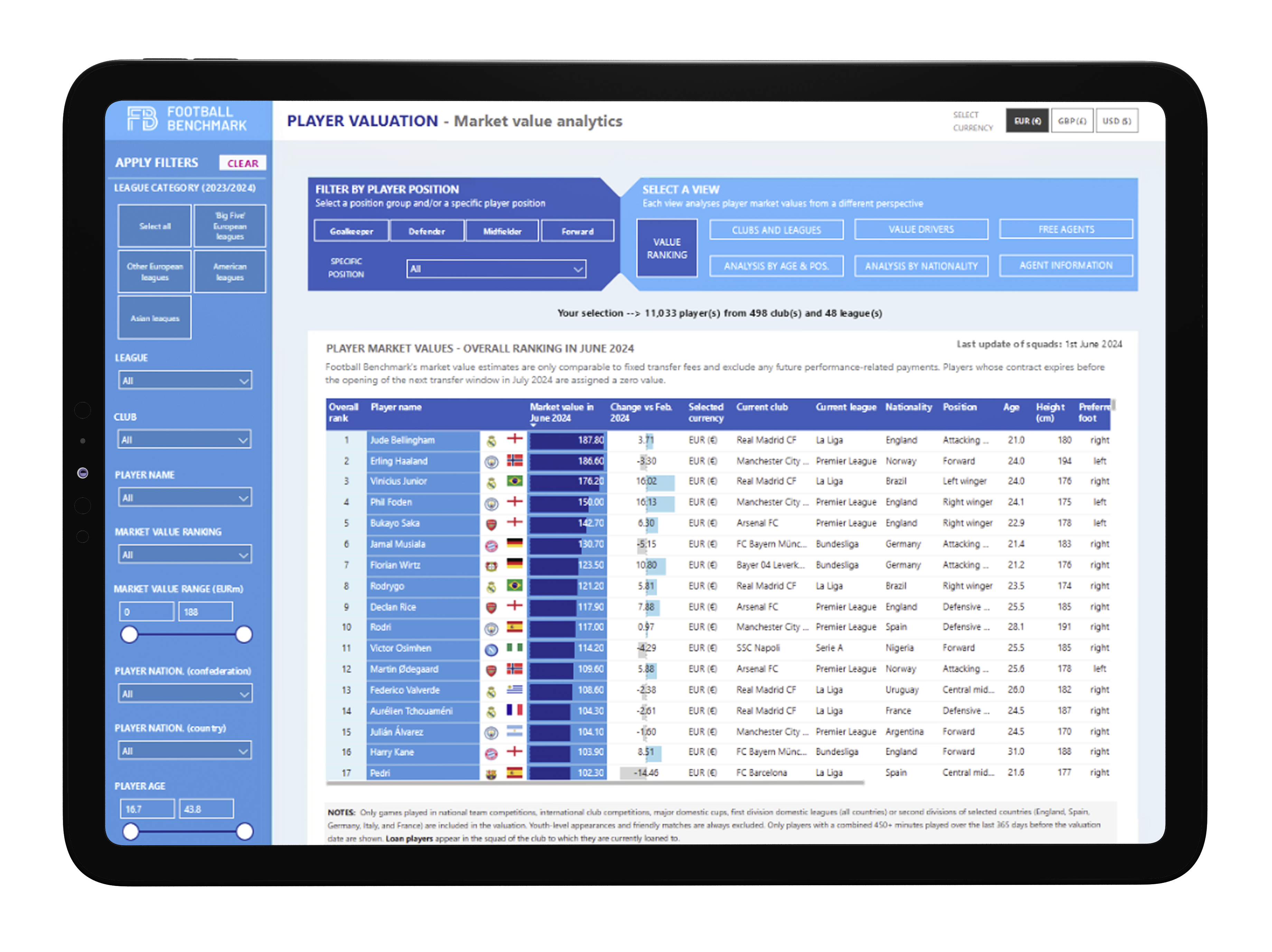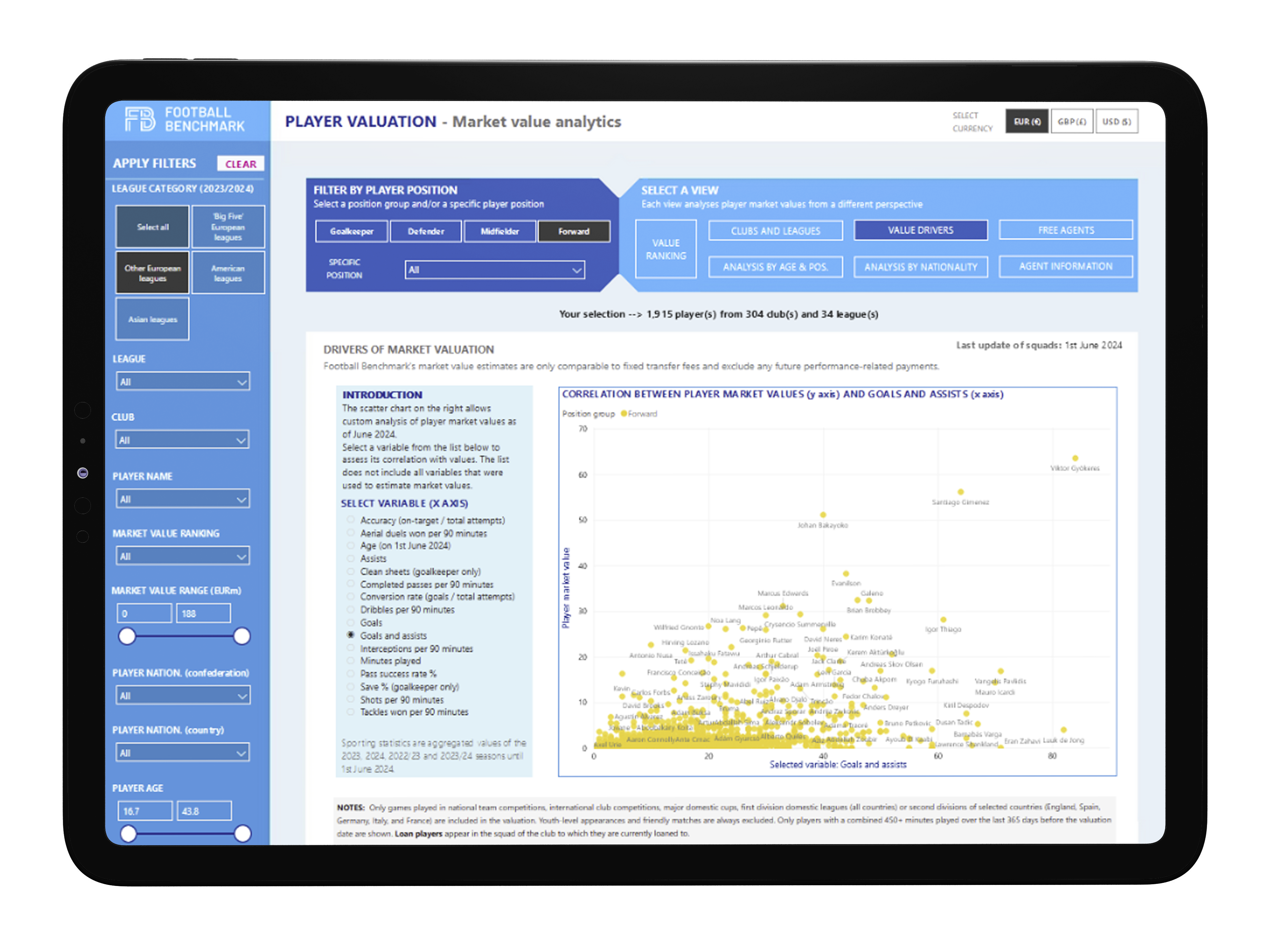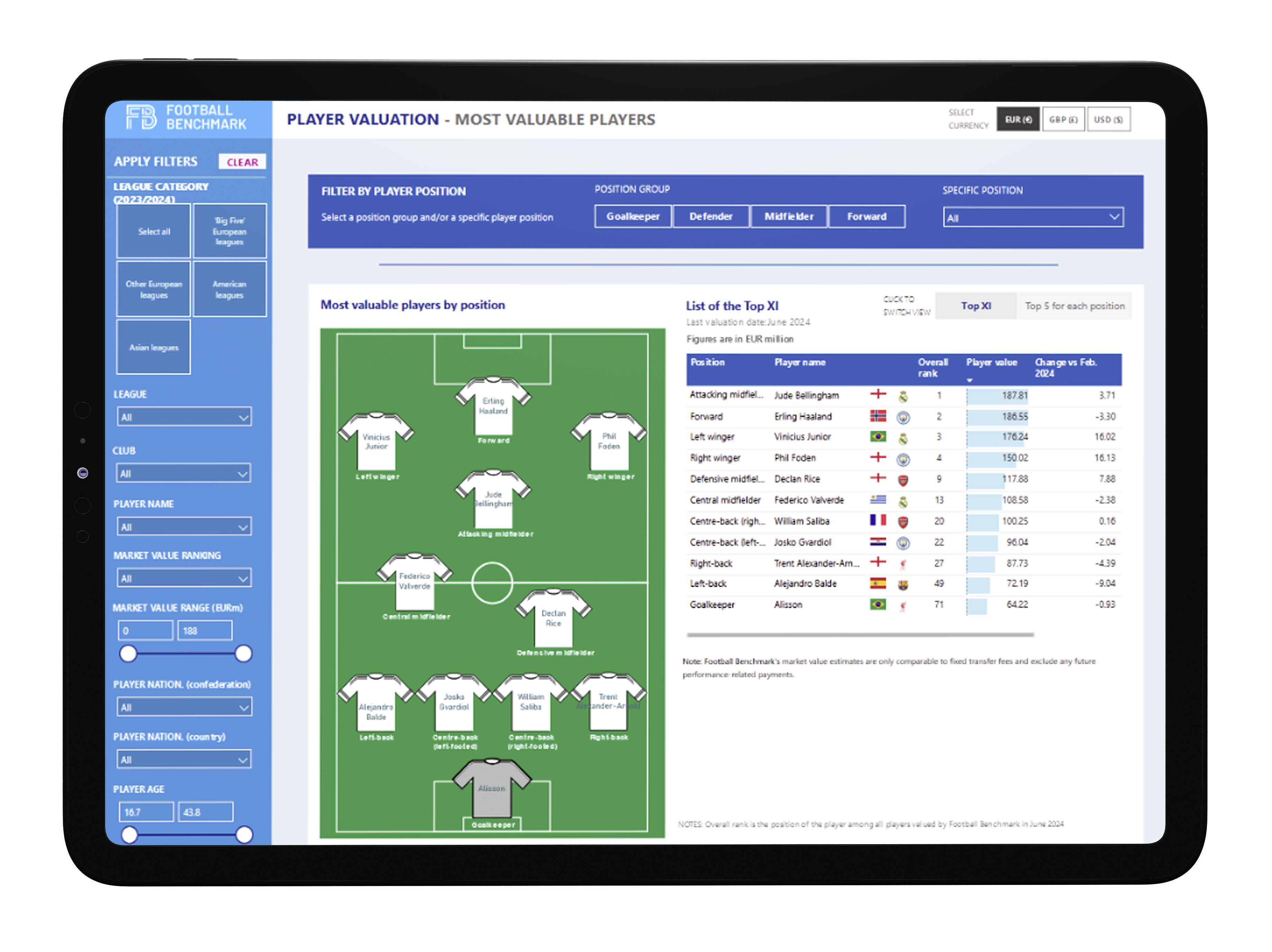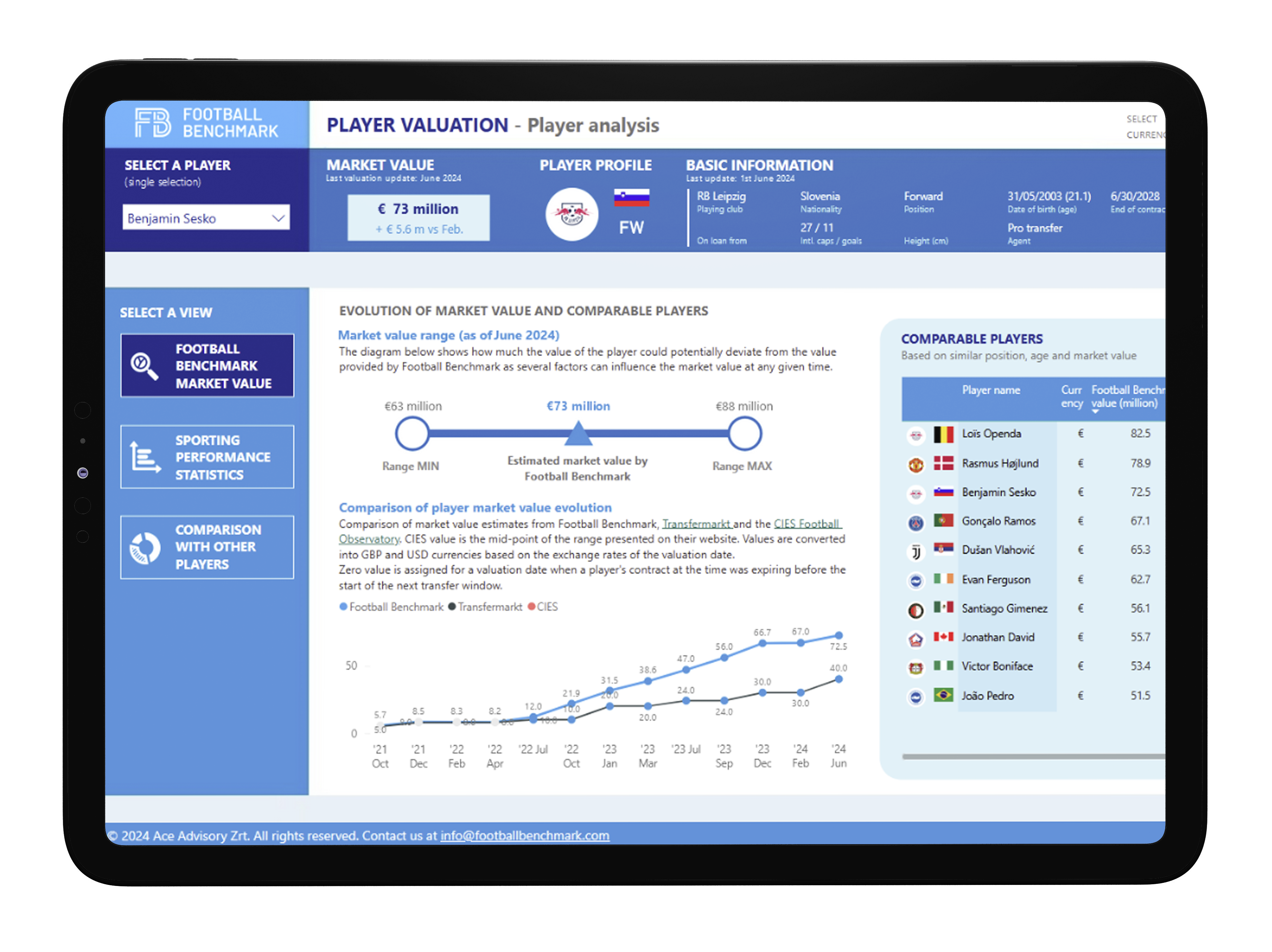Player Valuation
What is the Player Valuation Tool?
The Football Benchmark Player Valuation Tool provides estimations of professional football players' market values based on proprietary algorithms.It is important to note that in our Player Valuation Tool, the terms ‘market value’ and ‘player value’ specifically refer to the fair market value of a player’s contract at a given time (valuation date). This distinction is essential for accurately interpreting the disclosed values. Notably, one of the key inputs in our algorithms is the remaining length of the player’s contract with their current club, which significantly shapes how Football Benchmark ‘player values’ shall be understood.

Which players are valued?
The Player Valuation Tool appraises the value of all club players from the following twenty-five leagues:
English Premier League
English EFL Championship (second tier)
Spanish LaLiga
Spanish LaLiga 2 (second tier)
Italian Serie A
Italian Serie B (second tier)
German Bundesliga
German 2. Bundesliga (second tier)
French Ligue 1
French Ligue 2 (second tier)
Dutch Eredivisie
Belgian Pro League
Portuguese Primeira Liga
Turkish Süper Lig
Brazilian Serie A
Argentine Primera División
Russian Premier Liga
Austrian Bundesliga
Saudi Professional League
Swiss Super League
Danish Superliga
Scottish Premiership
Hungarian NB I
Mexican Liga MX
Major League Soccer
In addition, player valuations are available for 64 other European and South American clubs.
A player´s market value estimation is based on his matches played in first division domestic leagues, second divisions of selected countries (England, Germany, Spain, France and Italy), major domestic cups, international club competitions and national team competitions. The performance in the 365-day period prior to the valuation date is considered in our model. A player's total playing time must be at least 450 minutes over the analysed period in order to be eligible for value estimation. As a result, there could be players who are not yet included in our analysis, even though they play for a club featured in the platform.
How is a player's market value indication calculated?
The proprietary algorithms used for these purposes rely heavily upon an analysis of past football player transactions taking place during the last seven completed football seasons (from 2018/19 to 2024/25). After reviewing thousands of transfers, the Football Benchmark team has devised a linear regression model (generalized linear model) to identify the most relevant variables that influence the value of a player. All variables that have an impact on the transfer values and that could be collected were considered during the development phase of the models.
In doing so, several drivers – each with their own specific weight – were identified as key to estimating the market value of football players.
These are:
Player´s playing position (i.e. goalkeeper, defender, midfielder, forward);
Player's playing profile and role based on sporting statistics (i.e. target man, all-round striker, pure finisher for forwards);
Age and nationality;
Contract: assessment of a player´s contractual situation with his current club;
Individual sports performance: assessment of the player´s on-pitch performance (e.g. goals, assists, minutes played, dribbles, tackles);
Disciplinary actions (i.e. number of fouls, number of red and yellow cards);
Assessment of the player´s performance with his national team (e.g. number of international matches, international goals);
Assessment of the player´s media and commercial potential (if significant);
Team performance and characteristics: sporting results, league competitiveness, economic and financial aspects of the club, etc.;
Timing of player´s transfer and economic profiles of potential recruiting and selling clubs.
It is important to note that several models were developed in order to fully capture the specific characteristics of different playing positions. This means that goalkeepers, defenders, midfielders and forwards are valued on the basis of sporting performance variables that were found to be the most relevant to each position; for example, tackling is more important for the assessment of defenders than for forwards. However, several variables are common across all models (e.g. age, length of contract, performance with national team).

How often are the values updated?
Generally, we provide market values for four/five separate valuation dates each season: September (end of the summer transfer window), December, February (end of the winter transfer window), April and July (start of the summer transfer window). Changes in league scheduling can alter this timeline and we reserve the right to publish valuation results on other dates.

Where do the data come from?
Leading sports data company Hudl/Wyscout provides the sports performance data for the Football Benchmark Player Valuation tool and regularly provides us with the relevant sports data required to compute players’ market value estimates.
Price vs. Value: Two different concepts
Economic theory teaches us that price is what a person pays for a given product or service, whilst value is what any given product or service is worth. Actual transfer fees in football are often distorted by several factors such as terms and conditions of the specific financial/sporting situation of the seller or the buyer at the time of a transaction, the willingness of a player to leave or join a club, league-specific rules and regulations, terms of release clauses, etc.

LIMITING CONDITIONS AND ASSUMPTIONS
Acceptance and/or use of the Football Benchmark Player Valuation Tool constitutes acceptance of the assumptions and limiting conditions included therein.Scope of analysis — The pricing analysis of any asset or business is a matter of informed judgment. The Football Benchmark Player Valuation algorithms have been developed on the basis of information and assumptions summarised on the basis of the preparation presented above and include certain limitations and exclusions. The amounts presented have in some cases been rounded off from the more detailed final calculations. The provided market value estimates do not take into account performance-based bonuses that could be part of a potential player transfer fee. The estimates are only comparable to fixed transfer fees.
Nature of opinion — Our players´ value indications should not be construed as an opinion as to the fairness of an actual or proposed transaction, or an investment recommendation. Instead, they are the expression of our estimation of their value based on a consistently-applied methodology. For various reasons, the price at which a player might be sold in a specific transaction between specific parties, on a specific date, may be significantly different from our value estimates. Potential investors always need to perform their own investigation and analysis, and are advised to seek their own professional legal, financial and taxation advice in such matters.
Value conclusions — While every effort has been made to be consistent in the methodology applied in order to arrive at our value conclusions, in certain instances we have applied professional judgment to player-specific factors that were not addressed by Football Benchmark´s proprietary algorithms.
No verification of information provided — In developing our Player Valuation algorithms, we also rely upon publicly available data from recognised sources. We have not performed a detailed examination of this information nor tested its accuracy or reliability.
DISCLAIMER
Football Benchmark makes no representations nor provides any warranties regarding the accuracy or completeness of the information contained in this portal. Football Benchmark, its managers and employees expressly disclaim any and all liability for errors in omissions from the portal.The information contained in this portal is selective and does not purport to contain all the information that any reader, including potential investors, may require. Potential investors should conduct their own investigation and analysis, and are advised to seek their own professional legal, financial and taxation advice.
Nothing in this portal is, or should be interpreted or relied upon as a warranty or representation as to the future, nor should it replace the due diligence investigations which a prudent investor would be expected to make prior to investing.
Prospective investors are not to construe the content of this portal as investment, legal or tax advice. In making an investment decision, investors must rely on their own examination of the investment and the terms of the investment, including the merits and risks involved.

